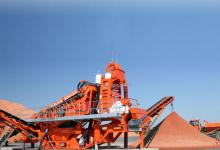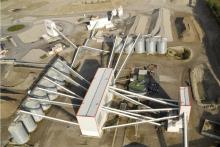
High PSV aggregates are vital to creating high skid resistant roads and are particularly popular in the UK, but without careful management reserves could run out. Claire Symes takes a look at this premium aggregates market
Rising traffic levels throughout Europe not only mean that the durability of roads is coming increasingly under scrutiny, but the role played by surfacing in terms of safety is also being placed in the spotlight. Advances in both braking and tyre technology have significantly improved stopping capabilities of modern cars but without similarly advanced road surfacing, the full safety potential cannot be realised.
Aggregates that can offer skid resistance throughout their service life are vital to provide high levels of safety and need to be selected carefully. According to aggregates specialist Gordon Lemon, who acts as a consultant to number of major quarrying companies in the UK, a good understanding of aggregate properties is essential.
"Aggregates selected for contact with tyres must meet two criteria," said Lemon. "Firstly, they must provide a deep texture, or macro texture, to minimise the build up of water on the surface, which is a major factor in controlling high speed skidding. The ability of an aggregate to provide macro texture is a function of its shape and the asphalt mix design.
"The second criterion is micro texture and this is a function of the composition of the aggregate, and having the right micro texture is important to maintain a dry contact between the aggregate and tyre. Aggregates with good micro texture can help control low-speed skidding." Micro texture is the most important factor for providing skid resistance and the ability of an aggregate to provide micro texture is defined by its geology. Lemon said that most aggregates used in skid resistant surfacing in the UK are sandstones, but igneous rocks such as hornfels and, occasionally, granites are sometimes suitable.
High PSV
One of the most significant tests is the polished stone value (PSV) which defines the ability of the aggregate to resist polishing. "The loose cementation of sand grains within sandstone offers high skid resistance, and a high PSV, by continually grinding away at the right rate to offer a rough texture throughout its service life. If the grains are too loosely cemented the aggregate will not stand up to continual trafficking, but if the grains are too well cemented, they will become polished over time and promote skidding rather than resist it," said Lemon.
The
In the UK, most of the quarries extracting sandstone aggregates with a PSV of more than 68 are located in South Wales, the west coast and central England and Scotland. "At the moment there are plenty of quarry sites in the UK to meet the current demand but almost all of them are away from the main population centres and the major road construction markets," said Lemon. "The other problem is that most are located in areas of outstanding natural beauty or National Parks, which not only presents a problem to exporting the material but is also likely to limit future extraction.
"Planning in the UK is carried out on a regional basis but because the main markets for these materials are in other regions, it can be difficult for the quarry operators to justify the need for new planning permissions."
Premium product
According to Lemon, the longest distance that it is financially viable to transport standard aggregates is around 50km, but for high PSV aggregates the distance can be much further. "The transport costs for high PSV materials can be up to five times the cost of the actual aggregate," he said. "In the UK, conventional crushed stone might cost £10/tonne (€14.6/tonne) in the local market and limestone around £13-14/tonne (€19-20.5/tonne), but high PSV materials typically cost up to £30/tonne (€44/tonne) in London and prices of around £50/tonne (€73/tonne) have been known in East Anglia." The market dynamics for high PSV aggregates in the UK are fairly isolated in Europe at the moment but Lemon believes that this will change with time. "Most countries in continental Europe do not offer the same level of skid resistance as the UK road network and operate more of a 'driver beware' policy. In mainland Europe high PSV aggregates are generally defined as those with a value of 58 or above," he explained. "But over the next decade, I think that will change as governments across Europe look towards further improving road safety." At the moment the lower demand for high PSV aggregates in the rest of Europe is working to the UK's advantage. The lower value of the materials elsewhere in Europe means that it is cost effective to import high PSV aggregates into the UK from France, Ireland and Norway.
"As demand for higher skid resistance in the rest of Europe grows, the potential for export will increase, along with the price. Countries like Germany have lots of sand resources but very few hard rock aggregates."
Quality vs quantity
The UK market for high PSV aggregates grew from 3.7 million tonnes in 1992 to 6.1 million tonnes in 2002, which suggests that the market could reach more than 7.3 million tonnes this year.
This demand does not sound high until it is put into context of current reserves. In 1992 reserves in active quarries in England were estimated to offer 20 years supply but by 2002 this had fallen to 15 years and Lemon believes that this positioning has not improved over the last five years. "Planning permissions are not keeping pace with increases in demand for conventional aggregates," he said. "But the position for premium products such as high PSV aggregates is even worse." During the last 10 years the road construction and maintenance market in the UK has not grown significantly and Lemon blames the dwindling stocks on inappropriate use of high PSV materials and demand for higher cubicity.
"Until the 1970s the demand for high PSV material was fairly low because it was only used as a single layer over hot rolled asphalt or for surface dressing," said Lemon. "Since then the growth in the use of negative texture materials has increased the demand five fold.
This is partly down to specification of high PSV on sites where it is not particularly necessary and also due to the broader range of sizes used in road construction today.
"Hot rolled asphalt generally used 20mm sized aggregates in a single layer but today's surfacing uses 14, 10 and 6mm sizes over the full depth. Crushing to achieve these gradings results in large quantities of high PSV dust for which there is no premium market." Lemon said that more research is needed into alternative uses for these fines but until then the quarry operator needs to focus on reducing production of fines. "This is not an easy task," he said. "The abrasive nature of high PSV aggregates means that operators can either use multiple cone crushers or horizontal or vertical impact crushers.
"The choice comes down to balancing the demand for aggregate shape with producing fewer fines. Many asphalt mix designs call for a cubicity value, or flakiness as it is known in the UK, of less than 10, where previously a value of 25 was considered ideal. Cone crushers can offer this level of cubicity but require multiple stage crushing, whereas impactors can produce a good shape in one pass but create more fines in the process.
"Despite these challenges, high PSV aggregates have a major role to play in maintaining and improving road safety in Europe. Nonetheless, the production and use of these materials will need to be carefully managed to make best use of the reserves available"









